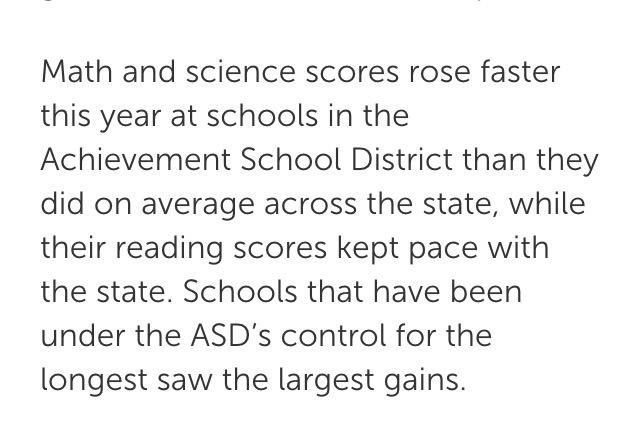“There is a decently large percentage of teachers who are saying that they feel evaluation isn’t fair,” he (state data guru Nate Schwartz) said. “That’s something we need to think about in the process we use to evaluate teachers … and what we can do to make clear to teachers how this process works so they feel more secure about it.”
This from a story about the recently released 2015 Educator Survey regarding teacher attitudes in Tennessee.
One reason teachers might feel the evaluation is unfair is the continued push to align observation scores with TVAAS (Tennessee Value-Added Assessment System) data – data that purportedly captures student growth and thereby represents an indicator of teacher performance.
From WPLN:
Classroom observation scores calculated by principals should roughly line up with how a teacher’s students do on standardized tests. That’s what state education officials believe. But the numbers on the state’s five point scale don’t match up well.
“The gap between observation and individual growth largely exists because we see so few evaluators giving 1s or 2s on observation,” the report states.
“The goal is not perfect alignment,” Department of Education assistant commissioner Paul Fleming says, acknowledging that a teacher could be doing many of the right things at the front of the class and still not get the test results to show for it. But the two figures should be close.
In order to be better at aligning observation scores with TVAAS scores, principals could start by assigning lower scores to sixth and seventh grade teachers. At least, that’s what the findings of a study by Jessica Holloway-Libell published in June in the Teachers College Record suggest.
Holloway-Libell studied value-added scores assigned to individual schools in 10 Tennessee districts — Urban and suburban — and found:
In ELA in 2013, schools were, across the board, much more likely to receive positive value-added scores for ELA in fourth and eighth grades than in other grades (see Table 1). Simultaneously, districts struggled to yield positive value-added scores for their sixth and seventh grades in the same subject-areas. Fifth grade scores fell consistently in the middle range, while the third-grade scores varied across districts
Table 1. Percent of Schools that had Positive Value-Added Scores in English/language arts by Grade and District (2013) (Districts which had less than 25% of schools indicate positive growth are in bold)
District Third Fourth Fifth Sixth Seventh Eighth
Memphis 41% 43% 45% 19% 14% 76%
Nashville NA 43% 28% 16% 15% 74%
Knox 72% 79% 47% 14% 7% 73%
Hamilton 38% 64% 48% 33% 29% 81%
Shelby 97% 76% 61% 6% 50% 69%
Sumner 77% 85% 42% 17% 33% 83%
Montgomery NA 71% 62% 0% 0% 71%
Rutherford 83% 92% 63% 15% 23% 85%
Williamson NA 88% 58% 11% 33% 100%
Murfreesboro NA 90% 50% 30% NA NA
SOURCE: Teachers College Record, Date Published: June 08, 2015
http://www.tcrecord.org ID Number: 17987, Date Accessed: 7/27/2015
In examining three-year averages, Holloway-Libell found:
The three-year composite scores were similar except even more schools received positive value-added scores for the fifth and eighth grades. In fact, in each of the nine districts that had a composite score for eighth grade, at least 86% of their schools received positive value-added scores at the eighth-grade level.
By contrast, results in math were consistently positive across grade level and district type:
In particular, the fourth and seventh grade-level scores were consistently higher than those of the third, fifth, sixth, and eighth grades, which illustrated much greater variation across districts. The three-year composite scores were similar. In fact, a majority of schools across the state received positive value-added scores in mathematics across all grade levels.
So, what does this mean?
Well, it could mean that Tennessee’s 6th and 7th grade ELA teachers are the worst in the state. Or, it could mean that math teachers in Tennessee are better teachers than ELA teachers. Or, it could mean that 8th grade ELA teachers are rock stars.
Alternatively, one might suspect that the results of Holloway-Libell’s analysis suggest both grade level and subject matter bias in TVAAS.
In short, TVAAS is an unreliable predictor of teacher performance. Or, teaching 6th and 7th grade students reading is really hard.
Holloway-Libell’s findings are consistent with those of Lockwood and McCaffrey (2007) published in the Journal of Educational Measurement:
The researchers tested various VAM models and found that teacher effect estimates changed significantly based on both what was being measured AND how it was measured.
That is, it’s totally consistent with VAM to have different estimates for math and ELA teachers, for example. Math questions are often asked in a different manner than ELA questions and the assessment is covering different subject matter.
So, TVAAS is like other VAM models in this respect. Which means, as Lockwood and McCaffrey suggest, “caution is needed when interpreting estimated teacher effects” when using VAM models (like TVAAS).
In other words: TVAAS is not a reliable predictor of teacher performance.
Which begs the question: Why is the Tennessee Department of Education attempting to force correlation between observed teacher behavior and a flawed, unreliable measure of teacher performance? More importantly, why is such an unreliable measure being used to evaluate (and in some districts, reward with salary increases) teachers?
Don’t Tennessee’s students and parents deserve a teacher evaluation system that actually reveals strong teaching and provides support for teachers who need improvement?
Aren’t Tennessee’s teachers deserving of meaningful evaluation based on sound evidence instead of a system that is consistent only in its unreliability?
The American Statistical Association has said value-added models generally are unreliable as predictors of teacher performance. Now, there’s Tennessee-specific evidence that suggests strongly that TVAAS is biased, unreliable, and not effective as a predictor of teacher performance.
Unless, that is, you believe that 6th and 7th grade ELA teachers are our state’s worst.
For more on education politics and policy in Tennessee, follow @TNEdReport
